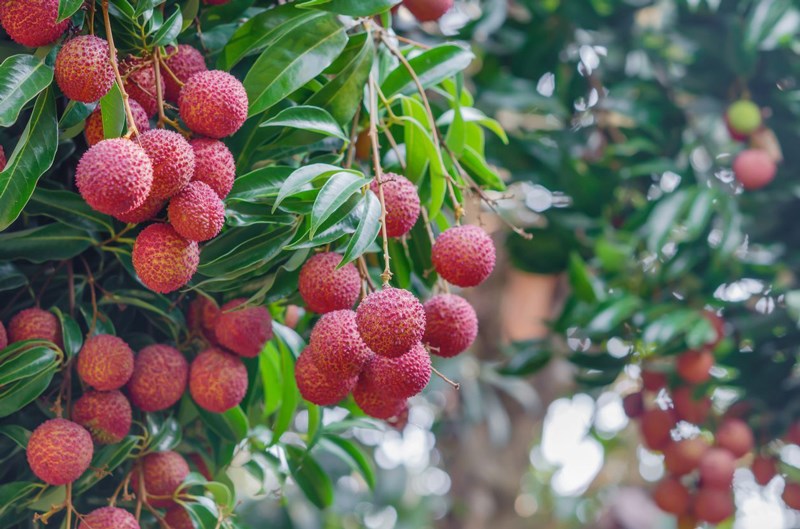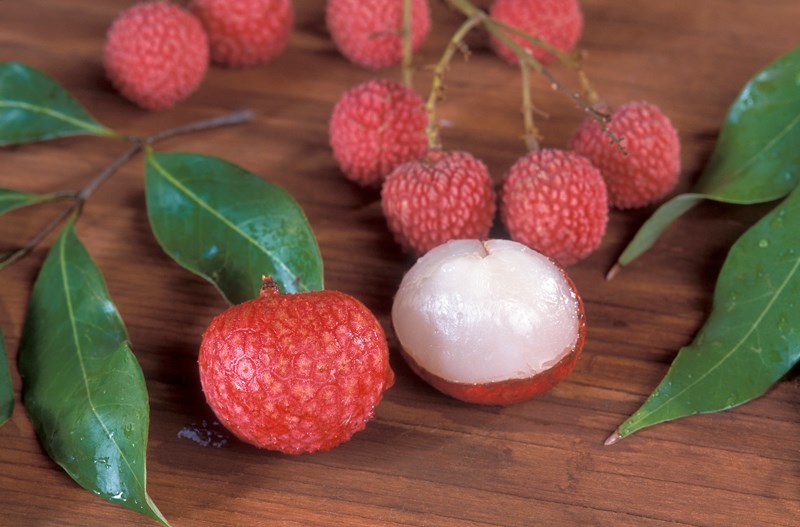Lychee is a delicious and nutritious fruit. Not only that, our ancestors have long used lychee as a medicine.
Lychee is also known as Lychee. Scientific name Litchi sinensis Radlk. (Nephellium litchi Cambess, Euphoria litchi Desf). Belongs to the Sapindaceae family.
Lychee trees are grown in Vietnam, also found in Cambodia, Laos, China, Thailand, and northern India.
Lychee is harvested in May-June, eaten fresh or dried or canned for later use. Lychee seeds are thinly sliced, dried or dried and used as medicine under the name of lychee seed.
In the seed coat (tử y) we often call lychee segments, the main sugar is glucose (66%); a small amount in the form of sucrose (5%); protein 1.5%; fat 1.4%; vitamin C (average 40mg in 100g of seed coat liquid); vitamin C2, vitamin A and B (these two vitamins are usually only found in fresh seed coat, when dried they are often lost), citric acid.
In lychee seeds (lễ chi nhân) there are 1-1.5% tannin, 1-1.2% ash, 10-12% moisture, 5-6% fat, alpha methylenecyclopropylglycine.

Lychee tree gives us precious medicine.
1. Uses and dosage
In ancient documents, it is said that the seed coat has a sweet, sour taste, is neutral or warm in nature, and is not toxic; it has the effect of nourishing blood, relieving thirst, reducing swelling, treating boils, making beans grow easily, eating a lot makes the face more beautiful, but in ancient authors, there are also authors who say that eating a lot causes fever, nosebleeds and toothache (Mau Hy Ung and Hoang Cung Tu).
Use 10-16g of dried seed coat per day.
Lychee seeds (lychee seeds) are also a medicine that has been used for a long time. According to ancient documents, lychee seeds have a sweet, astringent taste, are warm in nature, and are not toxic; they have the effect of dispersing cold, dampness and stagnant gas, and are a medicine for treating swollen and painful scrotum (hernia); and are also used to treat diarrhea in children.
Use 4 to 8g per day in powder form or decoction.
Other parts: In addition, people also use flowers, bark and roots to make water to gargle to treat sore throats and toothaches.

Lychee has many medicinal uses.
2. Some remedies from lychee
2.1 Stomachache, nausea:
Roast lychee seeds, peel off the outer shell and eat about 6 – 8g/time. Twice a day.
2.2 Stomach ache:
3g lychee seeds (prepared as above), 2g magnolia bark. Grind into fine powder, drink with warm water. 2-3 times a day.
2.3 Menstrual cramps or postpartum abdominal pain:
Burn 20g lychee seeds, 40g cyperus rotundus, grind into fine powder, drink with diluted salt water or rice water. Twice a day.
2.4 Women with lower abdominal pain (pain in the appendages) like needle pricks:
Slice lychee seeds as above, roast until black, star anise in equal amounts (4-8g), grind into fine powder, drink with warm wine, 3 times a day. Drink for many days until the symptoms disappear.
2.5 Inguinal hernia, orchitis:
Process lychee seeds as above, stir-fry until golden brown, pepper (stir-fried), kumquat seeds (tangerine seeds) stir-fry until golden brown.
All 3 ingredients are used in equal amounts, ground into fine powder, taken with warm water, 2-3 times a day, 6-8g each time.
Children should reduce the dose according to their age.
You can also use only lychee seeds, burn them into charcoal, mix them with alcohol to drink, with a dose of 4-6g. Or take lychee seeds processed as above, tangerine peel, equal amounts 10g, stir-fry until golden brown, sulfur 3g. Use in the form of fine powder. Divide into 2 doses to drink during the day.
2.6 Diarrhea due to spleen deficiency:
7 lychees, 5 jujubes. Boil to get water to drink many times a day.
2.7 Treatment of hiccups:
7 lychees, 6g fresh ginger, 4g brown sugar. Boil to drink.
2.8 Swollen and painful teeth:
Green lychee, add a little salt or burn it to ashes, grind it finely, and rub it on the tooth root.
3. Notes when eating lychee
Some people who eat lychee are poisoned with symptoms such as nausea, hives, severe abdominal pain, vomiting, diarrhea, difficulty breathing, low blood pressure… not due to the lychee itself but due to a poisonous fungus Candida tropicalis often found in the crown of overripe, crushed, rotten lychees. Sugar content, pH, and acid are necessary environments for fungi to grow. Therefore, you should not eat too much, especially when you see unusual changes in the quality of the fruit.
Eating a lot of lychee can cause increased blood sugar and heat in the body. Diabetic patients should only eat 4-5 lychees at a time. People who are prone to acne, prickly heat, and styes should not eat a lot of these fruits, because the high sugar content in lychee will increase blood sugar levels, creating an ideal environment for bacteria to grow.





